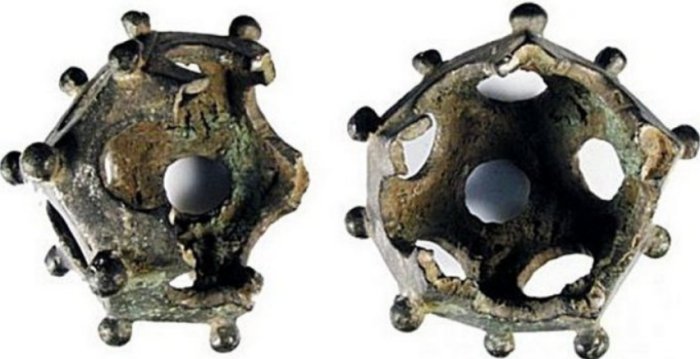Dodecahedron: Sophisticated Ancient Device Found In Europe And Asia
A. Sutherland - AncientPages.com - Over the years, almost thirty theories regarding mysterious dodecahedrons have been documented, many dismissed, and none considered satisfactory.
Roman bronze dodecahedron found in Tongeren, Gallo-Roman Museum, Tongeren, Leopoldwal, 1939, collectie Gallo-Romeins Museum Tongeren, 4002. Image credit: Public Domain
They are considered an ancient archaeological mystery despite many attempts to solve it.
The enigmatic artifact is a hollow bronze polyhedron with twelve pentagonal faces, each with a different-sized hole, thirty ridges, and twenty vertices decorated with solid balls of small diameter. It has persisted as an enigma within the annals of Gallo-Roman archaeological records to the present day. It still captivates scholars and researchers alike.
More than a hundred enigmatic objects have been discovered on Roman sites in Great Britain, Belgium, Germany, France, Italy, Luxembourg, Netherlands, Austria, Switzerland, Eastern Europe, and even Asia in Thailand, Burma, and Vietnam.
It is noteworthy to mention that these structures have also been unearthed in Asia, but on a considerably smaller scale, at locations such as Taxila in the Punjab province of Pakistan, Gummadiduru in India, and China and Vietnam.
However, they exhibit distinct characteristics that differ from those of the European dodecahedrons. For instance, those originating from Vietnam and India are crafted from gold, with diameters ranging from 4 to 9 millimeters and weights frequently less than a gram. Additionally, the holes drilled into the faces are of uniform diameter. These objects were believed to have symbolic significance rather than any practical application.
This discovery expands the geographical scope and significance of these archaeological findings.
The discovery of the European dodecahedron has occurred in diverse and remarkable locations, including riverbeds, public baths, a well military camps, a tomb, a hoard, a temple, and even within the confines of a well that had been filled.
The purpose behind the enigmatic distribution of this intriguing artifact is to ensure its visibility to as many individuals as possible. This deliberate distribution adds to the mystery surrounding its origin, leading to various theories about its use and significance in the ancient world.
The purpose of these odd objects, commonly known as Roman dodecahedrons, has been widely discussed. They are between four and eleven centimeters in size and date from the Roman Empire, between the 2nd and 3rd centuries. Interestingly, they have yet to learn what they were used for.
Did the Romans create these dodecahedrons, or were they named 'Roman' because many were unearthed in countries once part of the Roman Empire? This question raises exciting possibilities about their origin and purpose.
The artifact's origin is also unclear because it was never mentioned in the Roman, thoroughly kept accounts.
Two ancient Roman bronze dodecahedrons and an icosahedron (3rd c. AD) in the Rheinisches Landesmuseum in Bonn, Germany. The dodecahedrons were excavated in Bonn, Frechen-Bachem, and one icosahedron in Arloff. Image credit: Kleon3 - CC BY-SA 4.0 DEED
Some of the proposed suggestions regarding the device's use are possible. Still, it has yet to be explained why a relatively sophisticated device would be used instead of alternative means to achieve the desired function successfully.
Despite much speculation, the dodecahedron's function has not been scientifically determined. Some have suggested that it was a surveying instrument.
Some of these artifacts were discovered within coin chests, suggesting they held value for the Romans. Two other artifacts had remnants of wax inside. Were the objects used as flower stands, finger ring-size gauges, amulets, game dice, or even toys to throw and catch on a stick? They may have been candle holders in certain rituals; however, their peculiar shape seems ill-suited for this purpose, raising questions about their intended function.
In 1849, the Society of Antiquaries of London wrote that "A singular object of bronze, in the form of a hollow dodecahedron… with a ball attached to each angle; each of its pentagonal sides is pierced with a circular opening, the diameters of these perforations increasing gradually from six-tenths to about 1 ½ inch.
The 12-sized geometric artifacts (widely known as' Roman dodecahedrons' have been long-lasting enigma för archaeologists. Photo credit: British Museum
"Each side measures, in diameter, 2 1/5 inches. It was found in May 1768, at a depth of about 8 feet, on the north side of St. Peter's Church, Carmarthen. Several pieces of copper, curiously laid in flag bricks, were found at the same time, but they crumbled to dust.
"A similar bronze dodecahedron, found with copper coins at Aston, in Hertfordshire, in a field called Hagdale, was exhibited to the Society by Mr. North, June 28, 1739.
"A third, resembling these but of smaller size, and without balls at the angles, found near Fishguard, was sent by the Rev. Edward Harries of Llandysilio, Pembrokeshire, March 12, 1846."
What did our greatest minds of the ancient world think about the dodecahedron?
Plato vaguely wrote that the god used the dodecahedron to arrange the constellations in heaven. On the other hand, Aristotle added a fifth element, aither (aether in Latin), and suggested a theory that the heavens were made of this element. Still, he had no interest in matching it with Plato's fifth solid.
As for Pythagoras, this mysterious complex object was perceived as a symbolic representation of the Cosmos, of the Universal Sphere, a notion that Plato subsequently embraced.
Notably, the dodecahedron with equal faces can be inscribed within a sphere, a geometrical property that undoubtedly contributed to its philosophical significance.
Recently, people have suggested that the dodecahedron represents "a sacred symbol for Druids," but Plutarch (c. 46 – 120 AD), a Greek historian, biographer, and essayist, identified it as a vital instrument for zodiac signs. According to him, the twelve sides represent the twelve animals in the circle of the Zodiac and the twelve months. The thirty edges correspond to the number of days a month, and the multiplication of these two numbers gives 360.
An important question is: on what basis did Plutarch make this identification? One must also ponder the peculiar protrusions—were they merely ornamental embellishments, or did they hold any substantive significance?
The objects do not appear in any surviving pictures of the time, although they can be found in museums and many private collections. The dodecahedron remains a mystery.
Written by – A. Sutherland - AncientPages.com Senior Staff Writer
First version of this article appeared on AncientPages.com on May 14, 2014.
Copyright © AncientPages.com All rights reserved. This material may not be published, broadcast, rewritten or redistributed in whole or part without thexpress written permission of AncientPages.com
Expand for referencesReferences:
Phillips, J. P. “The History of the Dodecahedron.” The Mathematics Teacher 58, no. 3 (1965): 248–50.
Klarreich, Erica. “The Shape of Space.” Science News 164, no. 19 (2003): 296–97.
More From Ancient Pages
-
 Pre-Columbian People Of The Amazon Altered Their Landscape Thousands Of Years Earlier Than Previously Thought
Archaeology | Jun 14, 2021
Pre-Columbian People Of The Amazon Altered Their Landscape Thousands Of Years Earlier Than Previously Thought
Archaeology | Jun 14, 2021 -
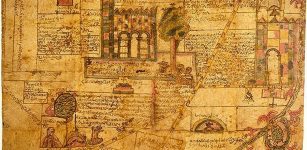 What Does The Mexican Codex Map Represent?
Ancient History Facts | May 21, 2018
What Does The Mexican Codex Map Represent?
Ancient History Facts | May 21, 2018 -
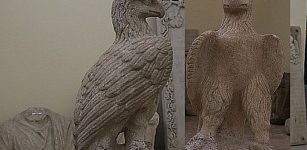 Two 2,000-Year-Old Marble Eagle Statues Found In Anatolian Hellenistic Temple
Archaeology | Aug 12, 2019
Two 2,000-Year-Old Marble Eagle Statues Found In Anatolian Hellenistic Temple
Archaeology | Aug 12, 2019 -
 A Painted Vault Lid Discovered In Royal Palace Of Ek’ Balam Will Shed Light On History Of The Acropolis Of Ek’
Archaeology | Sep 16, 2023
A Painted Vault Lid Discovered In Royal Palace Of Ek’ Balam Will Shed Light On History Of The Acropolis Of Ek’
Archaeology | Sep 16, 2023 -
 Marquis Of Haihun’s Tombs: Dressing Mirror With Confucius’ Portrait Re-Identified
Archaeology | Mar 4, 2017
Marquis Of Haihun’s Tombs: Dressing Mirror With Confucius’ Portrait Re-Identified
Archaeology | Mar 4, 2017 -
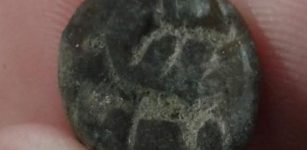 Rare 3,000-Year-Old Seal From The Time Of King David Discovered
Artifacts | Sep 28, 2015
Rare 3,000-Year-Old Seal From The Time Of King David Discovered
Artifacts | Sep 28, 2015 -
 Enigma Of Lycurgus Of Sparta – Great Reformer And His Foundation Of A Warlike Superior State
Featured Stories | Jan 9, 2023
Enigma Of Lycurgus Of Sparta – Great Reformer And His Foundation Of A Warlike Superior State
Featured Stories | Jan 9, 2023 -
 Why Was The Medieval Town Of Wagrain Suddenly Abandoned 1,300 Years Ago?
Archaeology | Oct 7, 2024
Why Was The Medieval Town Of Wagrain Suddenly Abandoned 1,300 Years Ago?
Archaeology | Oct 7, 2024 -
 Ancient Greeks Had Great Understanding Of Weather And Climate
Civilizations | Sep 7, 2015
Ancient Greeks Had Great Understanding Of Weather And Climate
Civilizations | Sep 7, 2015 -
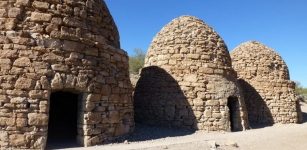 Arizona’s Enigmatic Beehive-Shaped Stone Coke Ovens
Featured Stories | Jul 15, 2023
Arizona’s Enigmatic Beehive-Shaped Stone Coke Ovens
Featured Stories | Jul 15, 2023 -
 Declining Fertility Rates May Explain Neanderthal Extinction
Archaeology | Jun 3, 2019
Declining Fertility Rates May Explain Neanderthal Extinction
Archaeology | Jun 3, 2019 -
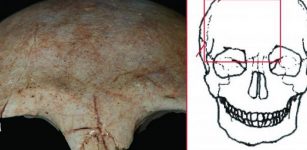 Ancient Warfare And Continuous Rise In Global Population – Is There A Connection?
Archaeology | Sep 13, 2021
Ancient Warfare And Continuous Rise In Global Population – Is There A Connection?
Archaeology | Sep 13, 2021 -
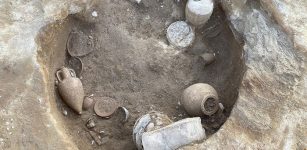 Rare Find Provides New Insight Into Etruscan Life Under Rome
Archaeology | Sep 3, 2022
Rare Find Provides New Insight Into Etruscan Life Under Rome
Archaeology | Sep 3, 2022 -
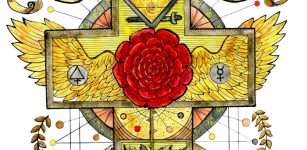 Rosicrucians: Facts And History About The Mysterious Secret Society
Featured Stories | Oct 20, 2016
Rosicrucians: Facts And History About The Mysterious Secret Society
Featured Stories | Oct 20, 2016 -
 Modern Humans Have Their Homeland In Botswana – New Study
Archaeology | Oct 29, 2019
Modern Humans Have Their Homeland In Botswana – New Study
Archaeology | Oct 29, 2019 -
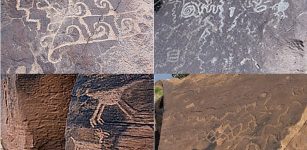 Lyman Lake Petroglyphs And Famous Kokopelli-Flute Player Left By Ancestors Of The Hopi Indians
Civilizations | Nov 26, 2018
Lyman Lake Petroglyphs And Famous Kokopelli-Flute Player Left By Ancestors Of The Hopi Indians
Civilizations | Nov 26, 2018 -
 Why Are The 2,000-Year-Old Roman Walls Found In Switzerland An ‘Archaeological Sensation’?
Archaeology | Sep 15, 2023
Why Are The 2,000-Year-Old Roman Walls Found In Switzerland An ‘Archaeological Sensation’?
Archaeology | Sep 15, 2023 -
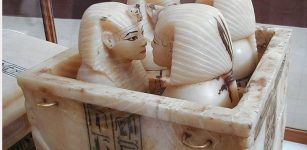 Canopic Jars: Funerary Tradition Of Ancient Egyptians And Their Beliefs In Afterlife
Ancient Traditions And Customs | Jun 23, 2017
Canopic Jars: Funerary Tradition Of Ancient Egyptians And Their Beliefs In Afterlife
Ancient Traditions And Customs | Jun 23, 2017 -
 Understanding The Green Sahara’s Collapse
Earth Changes | Aug 22, 2024
Understanding The Green Sahara’s Collapse
Earth Changes | Aug 22, 2024 -
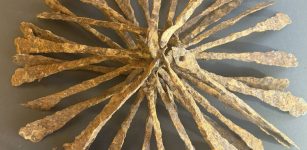 Rare Viking Age Treasure Found By Woman Cleaning The House
Archaeology | Apr 20, 2023
Rare Viking Age Treasure Found By Woman Cleaning The House
Archaeology | Apr 20, 2023




